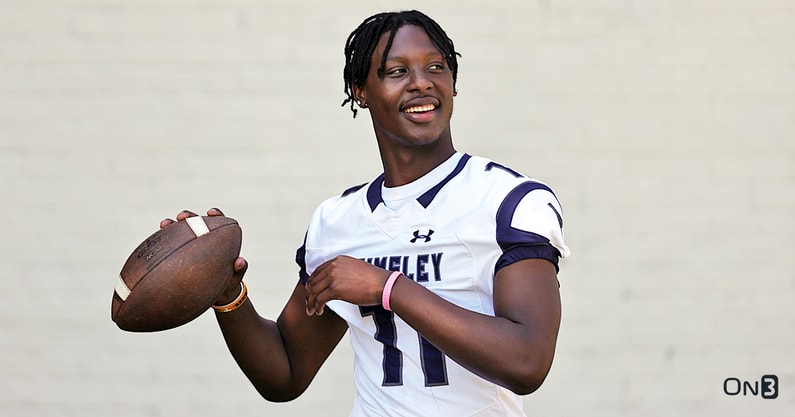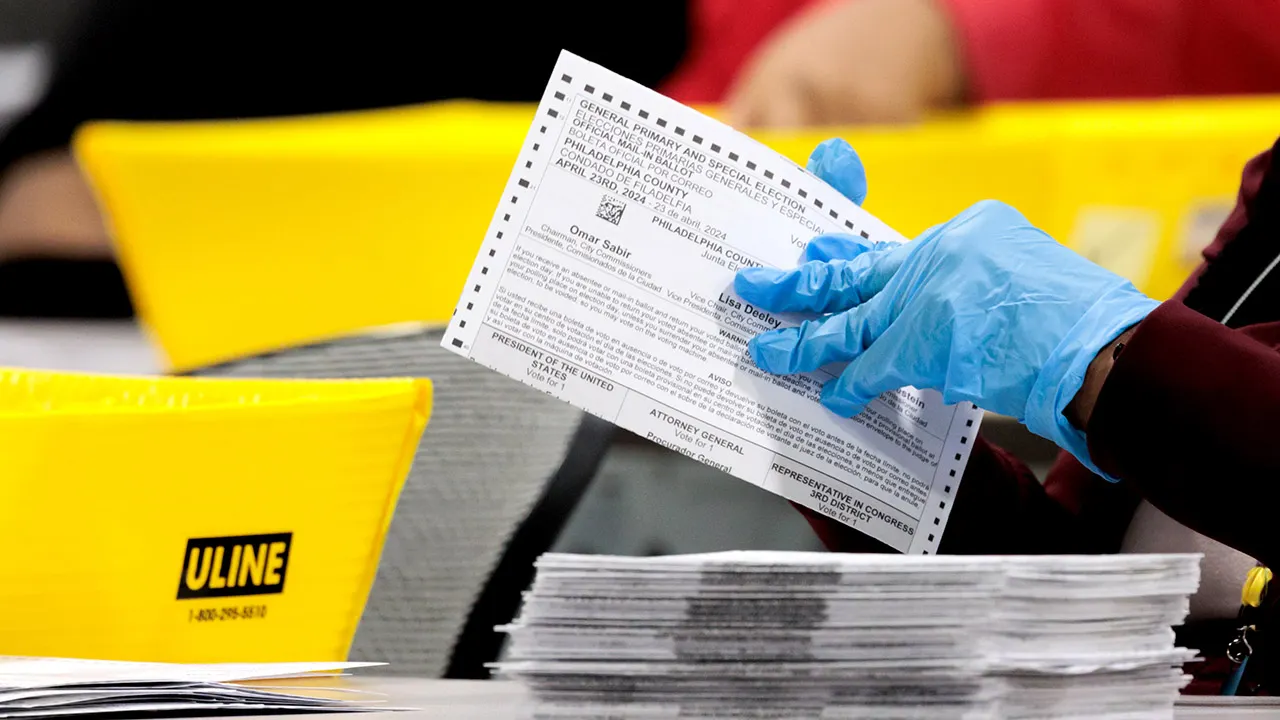Entertainment
Review: The Tarell Alvin McCraney era begins at the Geffen with powerful 'The Brothers Size'

Playwright and Oscar-winning screenwriter Tarell Alvin McCraney (“Moonlight”) was appointed artistic director of the Geffen Playhouse last year, but the McCraney era really began on Thursday night with the opening of a muscular revival of “The Brothers Size” at the Geffen Playhouse’s intimate Audrey Skirball Kenis Theater.
The play, part of the acclaimed trilogy “The Brother/Sister Plays,” launched McCraney’s meteoric rise in the American theater. McCraney was still a student at the Yale School of Drama when “The Brothers Size” was first produced. When I saw the play at the Public Theater in 2009 as part of the trilogy, I was keenly aware of being in the presence of a breakthrough talent.
What stood out about all three plays (including “In the Red and Brown Water” and “Marcus; or the Secret of Sweet”) was the freedom of the playwriting voice — the mix of lyricism and raw realism, the musicality blending joy and pain and the playful theatricality that trusted the imaginations of theatergoers and turned stage directions into spoken-word poetry. But none of this would have had the impact were it not for the sensitivity illuminating marginalized lives, a sensitivity capable of deconstructing race, class and gender while honoring the cultural soil from which the characters have emerged.
Alani iLongwe, left, and Sheaun McKinney in “The Brothers Size” at the Geffen Playhouse.
(Jeff Lorch)
Drawing on West African spiritual traditions, “The Brothers Size” relates the mythic story of two bayou country Louisiana brothers in conflict that is as tender as it is fierce. But the real subject is the plight of modern Black masculinity, victimized by white supremacy and harassed by a justice system that would rather lock up Black men than provide them with decent opportunities.
Hardworking Ogun Size (Sheaun McKinney) is unyieldingly committed to the straight and narrow path. That is not the preferred road of his younger brother, Oshoosi Size (Alani iLongwe), who has been recently released from prison.
Oshoosi resents Ogun’s martinet ways. He’d rather sleep late than wake up before dawn for a grueling day of fixing cars under his brother’s browbeating supervision. “That’s your job,” Oshoosi tells him. “That car shop got your name, that’s your job.” Ogun, knowing that employment is part of Oshoosi’s parole conditions, pointedly asks where’s his job then.
The names of the characters are taken from Yoruba mythology. Ogun is a warrior associated with metal work; Oshoosi is named after a wandering spirit renowned for hunting as well as contemplation and artistic pleasure.
There’s a third character, Elegba (Malcolm Mays), whose name signifies the trickster. And that is indeed the part he plays in what develops into a contest for Oshoosi’s soul.
Ogun wants to protect his brother from succumbing to the same mistakes. Elegba, jealous of the brothers’ bond, wants to liberate the erotic life of his former fellow inmate and bestows on him a gift that is simultaneously a ticket to independence and a trap.
Oshoosi must choose between different forms of freedom and different kinds of imprisonment. Can he deny his flesh and blood longings and his yearning for relief from an enduring sorrow?
The homoerotic dimension of Oshoosi and Elegba’s relationship is undeniable, but in this co-production with New York’s the Shed, director Bijan Sheibani doesn’t allow the queerness to dominate the play’s larger exploration of Black masculinity. Of the four productions I’ve seen of the play, including the Old Globe’s and the Fountain Theatre’s, this is perhaps the straightest.
Which isn’t to say that it’s repressed. Gay love and lust break through, but the revival is more curious about the range of outlets for tenderness among Black men. “Try a Little Tenderness,” the Otis Redding classic, figures prominently in a play in which acceptable expressions of love between men is punishingly limited, leaving an ache that can grow dangerous when unconsoled.
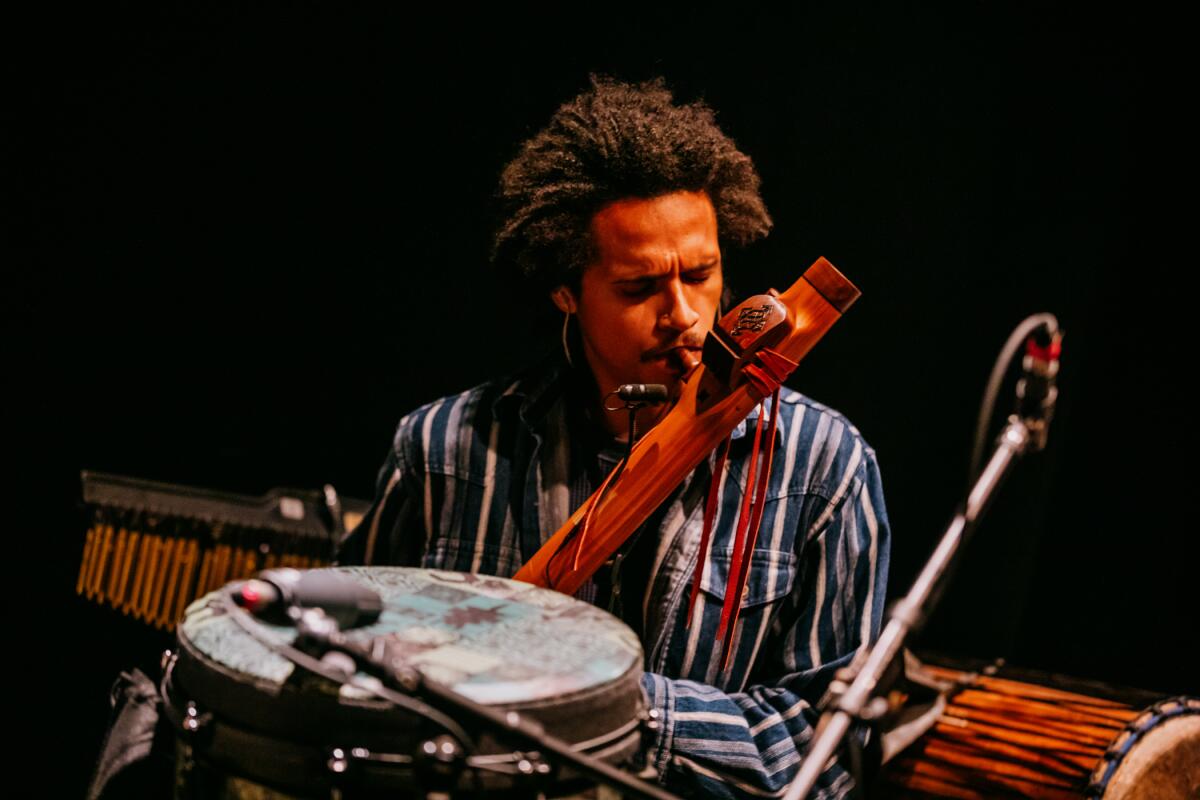
Sound designer, composer, musician Stan Mathabane in “The Brothers Size” at Geffen Playhouse.
(Jeff Lorch)
Ideally suited to the Geffen Playhouse’s second stage,“The Brothers Size” unfurls in darkened concentration. The audience surrounds the playing area as though witnessing a prize fight or highly athletic dance piece.
The black stage is encircled with white powder, creating a special zone of theatrical imagination. Musician, composer and sound designer Stan Mathabane supplies live accompaniment that lends the action a percussive build.
Suzu Sakai’s scenic design, Adam Honoré’s lighting and Juel D. Lane’s choreography work in tandem to intensify the sense of propulsive physical theater. Dede Ayite’s costumes conceal the characters’ individuality unnecessarily, but Sheibani seems opposed to superficial over-illustration and has the actors discover the roles anew through the personal textures they bring.
McKinney’s Ogun is the clearest presence on stage, a reflection not only of his more single-minded character but also of the lucidity of his playing. iLongwe gives vent to the furious restlessness inside Oshoosi without losing sight of the grief that’s animating it.
Mays’ Elegba is too cagey to be pinned down. He lays down temptations and then acts as though Oshoosi is simply following the dictates of his own wild nature. Here, Elegba’s jealousy is as complex as Ogun’s tough love. Oshoosi, drowning in emotional need, is only cast further at sea by the battle to control him.
McCraney, who translates buried anguish into monologues of rough delicacy rarely found outside the plays of August Wilson, finds the mythological patterns in lives that have been underrepresented and uncompassionately seen. For all the high testosterone conflict in “The Brothers Size,” the play makes a social justice case for the healing power of male vulnerability and the saving grace of brotherly (in the widest sense of the word) love.
‘The Brothers Size’
Where: Audrey Skirball Kenis Theater at Geffen Playhouse, 10886 Le Conte Ave., L.A.
When: 8 p.m. Wednesdays-Fridays, 3 and 8 p.m. Saturdays, 2 and 7 p.m. Sundays. Ends Sept. 8
Tickets: $45–$129
Contact: (310) 208- 2028 or www.geffenplayhouse.org
Running time: 1 hour, 30 minutes (no intermission)

Movie Reviews
THE CROW (2024) Review

Dominant Worldview and Other Worldview Content/Elements:
Strong pagan worldview with strong false religion/theology and strong occult elements but mixed with some Christian and moral elements, including some Christian symbols and metaphors in a dark battle against demonic evil, which posits a world where, sometimes, a dead person with intense feelings of love for another person or other people who died can return to life and set things right in a story about an evil man has made a pact with the Devil and has killed a young man’s “soul mate” lover, young man returns to life to obtain justice for his lover and save them both from Hell and movie creates sympathy for the hero to defeat the evil villain and save his lover, but something goes wrong and the young man is doomed to never to rejoin his lover after she resurrects, and so he sacrifices himself to be doomed to save her, but he still hopes that one day they will reunite in Heaven or the Afterlife, plus there are some Romantic notions about innocence and love mixed in within the movie’s worldview content;
Foul Language:
At least 39 obscenities (including many “f” words) and one strong profanity using the name of Jesus;
Violence:
Lots of extreme violence (among the most brutal we’ve ever seen at MOVIEGUIDE® in its history), and some strong violence includes two young lovers are captured and suffocated to death using two plastic bags in pretty graphic scene, and the title character shoots many bad guys to death in brutal ways, the most brutal such deaths occur in lengthy battle in lobby of opera house while opera is performed with the title character comes back to life and can’t be killed, stabbing many bad guys to death with a samurai sword and shooting bad guys in brutal ways including inserting the sword into one bad guy’s mouth and splitting another guy’s head, bad guys shoot the title character multiple times but he can’t be killed though he often stumbles and falls then rises again, bad guy stabs the title character through the chest with the character’s own sword, but the title character survives, title character breaks arms and legs of some bad guys during all the fighting, bad guy shoots a friend of the title character’s through the head, brutal fight between the title character and the main villain, people descend downward into deep water that in a symbolic way is supposed to lead them to Hell, main villain has made a deal with Satan to send “innocent” victims to Hell so the villain could live forever, one scene show the main villain whispering to a young woman and making her brutally kill another young woman (that’s how the villain allegedly makes the “innocent” girls he entices fit for Hell);
Sex:
Depicted scene of fornication in two shots, and an example of implied fornication;
Nudity:
Rear male nudity during sex, and some images of upper male nudity;
Smoking and/or Drug Use and Abuse:
No tobacco use but two scenes of apparent marijuana smoking, and a scene where a young man and woman take an illicit pill of some kind; and,
Miscellaneous Immorality:
Villain made a pact with the Devil, villain commands a criminal enterprise, villain deceives young people to corrupt them and gain new victims for Satan.
THE CROW (2024) is a reboot of a 1994 movie about a supernatural avenger who rises from the grave to get justice for him and his soul mate who were murdered by an evil man who’s made a deal with the Devil to corrupt innocent souls and send them to Hell. Based on a comic book series created in 1989, THE CROW has a strong, slightly mixed pagan worldview with false theology and occult themes combined with some light Christian, moral content, lots of strong foul language, some sexual immorality, and some of the most extreme and brutal violence MOVIEGUIDE® has ever seen in a movie.
The movie begins with a young woman named Shelly running from the henchman of an evil man named Vincent. Vincent has made a deal with the Devil to corrupt the souls of innocent young people and send them to Hell, in exchange for immortality. Vincent prefers young women, especially budding musical artists.
Shelly finds refuge in an isolated facility for juvenile delinquents, where she falls in love with a tattooed young man named Eric. However, Vincent’s minions, with help from Shelly’s corrupt mother, find her location. So, Eric helps Shelly escape the facility. Sadly, though, Vincent is able to finally track them down, and his men suffocate Eric and Shelly to death with plastic bags in a disturbing scene of murder.
Eric imagines Shelly and him falling downward to the bottom of the ocean. However, he suddenly wakes up in a railyard surrounded by crows. A mysterious older man tells Eric that, when a person dies, sometimes something so bad happens that your soul “cannot rest until you put the wrong things right.”
Eric vows to kill all the people who took part in Shelly’s murder. The older man promises that, if Eric keeps his love for Shelly “pure,” they can both return from the dead.
A violent battle between Eric and Vincent’s forces ensues on the streets of New York, culminating in an opera house and at Vincent’s country estate.
THE CROW is a paint-by-numbers revenge thriller with flashes of gothic horror. It has a strong pagan worldview containing false religion and occult elements. These are mixed with some Christian allusions and symbols and Romantic, Christian notions of innocence and sacrificial love. THE CROW also has lots of strong foul language, brief sexual immorality, and some of the most extreme and brutal violence MOVIEGUIDE® has ever seen in a movie.
Movie Reviews
Touch: cross-cultural love story by turns tender and hollow

Set at the outbreak of the Covid-19 pandemic, Touch opens as Kristofer (played by Icelandic musician Egill Olafsson) discovers his memory is fading and, heeding the advice of his doctor to resolve any unfinished business, sets off for London, despite the imminent threat of a worldwide lockdown.
Through a series of flashbacks, we meet the younger Kristofer (played by the director’s son Palmi Kormakur) in London at the end of the 1960s.
Disillusioned by the contemporary political landscape, he drops out of university and takes a job washing dishes at a Japanese restaurant, where he is taken under the wing of the proprietor, Takahashi (Masahiro Motoki).
He meets Takahashi’s beautiful daughter Miko (model Koki, also known as Mitsuki Kimura, the daughter of Japanese pop icons Takuya Kimura and Shizuka Kudo) at the restaurant, and the pair soon begin a passionate affair.
The structure of Touch sees the events of the past and present converge in a climactic revelation that explains why Kristofer and Miko’s relationship ended.
Suffice to say, Miko and her father fled Hiroshima shortly after the atomic bomb was dropped in August 1945, with the dream of starting a new life in London.
Try as they might, the lingering impact of the event and the stigma of being hibakusha – atomic bomb survivors – would continue to impact their lives for many decades to come.
In Touch, his direction is gentle and unobtrusive, almost to a fault. The film’s perspective aligns with Kristofer, as he, and the audience, is kept in the dark while the film’s Japanese characters wrestle with their trauma off screen.

Rather than attempt to explore the deep emotional scars that burden Miko and her family, the film prioritises the nostalgic reminiscences of Kristofer’s first love.
During these moments, Touch captures moments of genuine warmth and youthful passion. But elsewhere the film proves hollow and reductive.
Miko and her family’s struggles remain largely unexplored, portrayed by Olafur and his director as simply the mystifying enigmas of an exotic people.
Entertainment
Oasis is 'definitely maybe' reuniting after 15 years

Backbeat, the word is on the street that Oasis is finally reuniting after 15 years.
After British newspaper the Sunday Times reported this weekend that feuding brothers Noel and Liam Gallagher were likely in the process of getting the band back together, Liam Gallagher seemed to confirm the rumors on social media.
In response to a Sunday Times post reporting that the siblings and former bandmates had “settled their differences” and would be returning to the stage as Oasis in London and Manchester next summer, Liam Gallagher wrote on X, “See you down the front.”
The “Wonderwall” and “Don’t Look Back in Anger” hitmakers are slated to play “multiple vast gigs” at Manchester’s Heaton Park and London’s Wembley Stadium, according to unnamed “industry insiders” cited in the Sunday Times.
Representatives for Oasis, Heaton Park and Wembley Stadium did not immediately respond Sunday to requests for comment.
After splitting up in 2009, frontman Liam Gallagher and guitarist Noel Gallagher pursued solo endeavors, and many Oasis loyalists lost hope that the siblings would ever repair their relationship and revive the act.
For a decade and a half the pair has consistently been called former bandmates. On Sunday, however, Liam Gallagher stoked fans’ excitement amid the reunion speculation by cryptically musing that he “never did like that word FORMER” on X.
The comeback rumors surfaced just days before the 30th anniversary of Oasis’ debut studio album “Definitely Maybe.”
The British rock band is also famous for its seminal sophomore album “(What’s the Story) Morning Glory?” as well as hit songs such as “Wonderwall,” “Don’t Look Back in Anger,” “Stop Crying Your Heart Out” and “Champagne Supernova.”
-

 Minnesota1 week ago
Minnesota1 week agoReaders and writers: Plenty of thrills and danger in these Minnesota author’s mysteries
-

 Technology4 days ago
Technology4 days agoBreakthrough robo-glove gives you superhuman grip
-
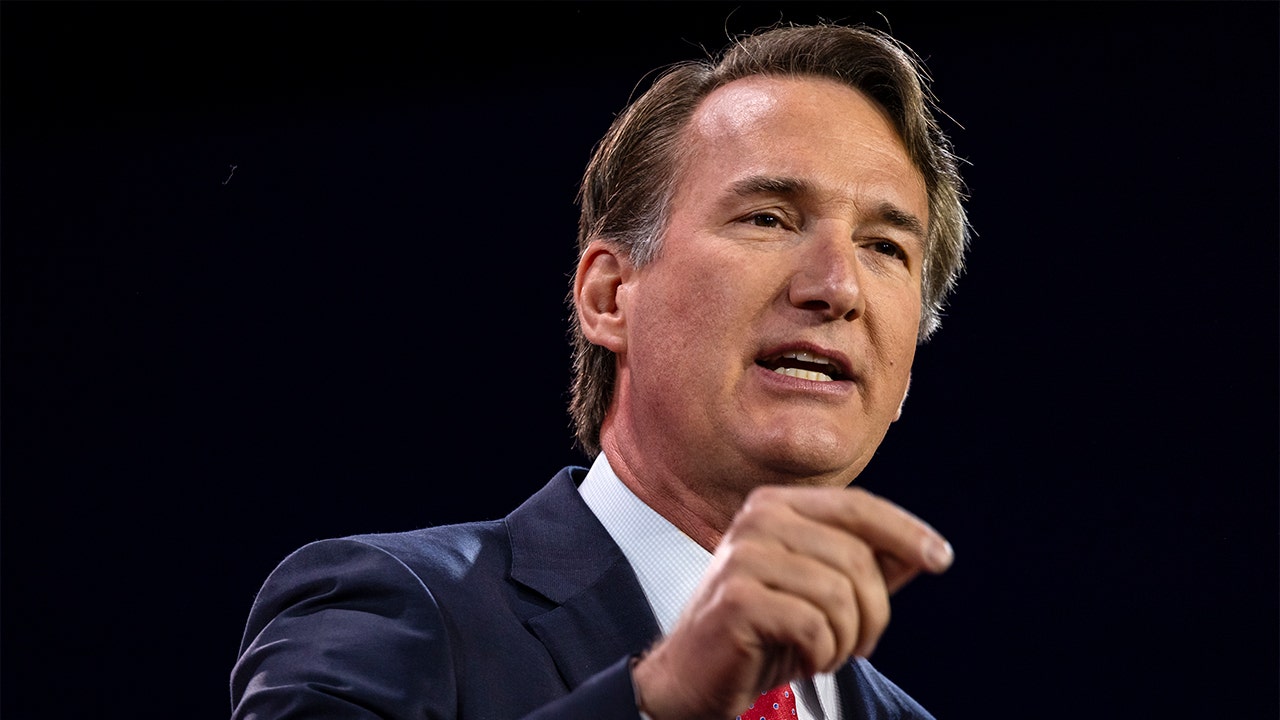
 Politics1 week ago
Politics1 week agoYoungkin takes victory lap against 'losing states' as Virginia marks $1B surplus: 'The playbook works'
-

 News1 week ago
News1 week agoOver 100 of Donald Trump’s companies make no money: Financial disclosures
-
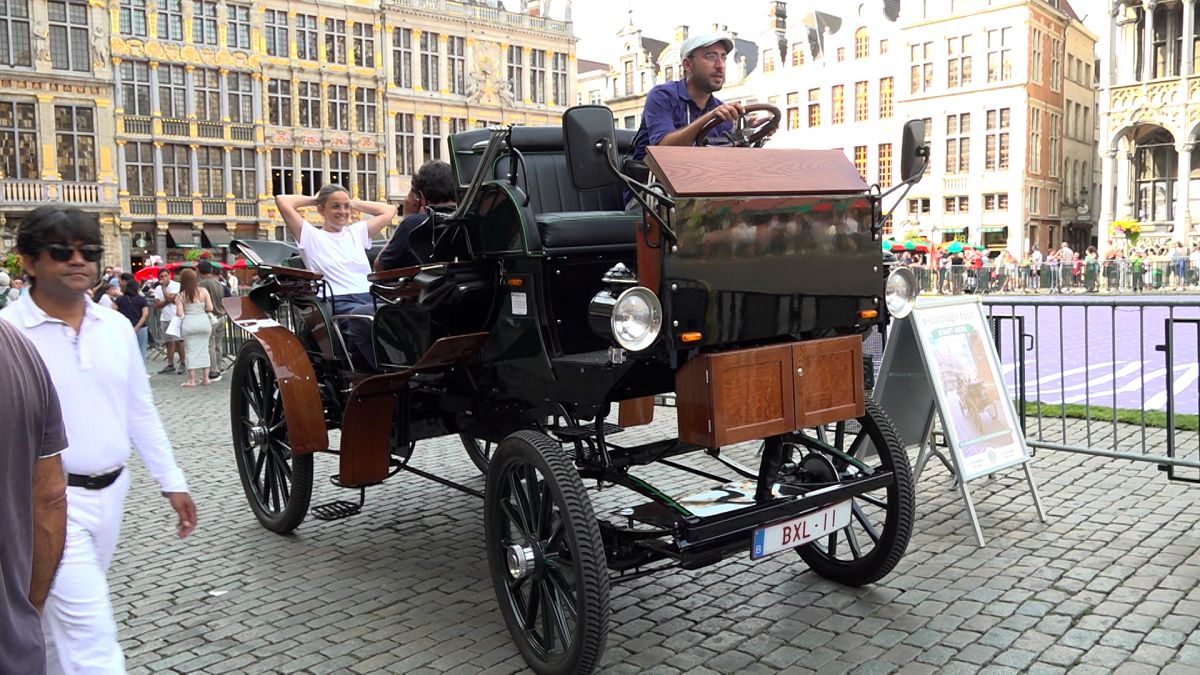
 World1 week ago
World1 week agoBrussels switches from horse-drawn carriages to electric ones
-

 News6 days ago
News6 days agoVideo: Biden Delivers Keynote on First Night of D.N.C.
-

 Politics1 week ago
Politics1 week agoPolitical parallels between 1968 and 2024 as the Democrats return to Chicago
-

 Politics1 week ago
Politics1 week agoFlorida GOP lawmaker wants to ban smoking on streets, but supports legalizing marijuana
